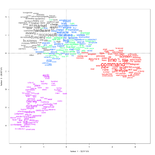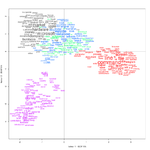Iramuteq: Difference between revisions
Jump to navigation
Jump to search
(Created page with "{{Data mining and learning analytics tools |field_logo=Iramuteq-logo.png |field_screenshot= |field_name=IRaMuTeQ |field_developers=Pierre Ratinaud, LERASS |field_website=http:...") |
mNo edit summary |
||
| (4 intermediate revisions by the same user not shown) | |||
| Line 1: | Line 1: | ||
{{Data mining and learning analytics tools | {{Data mining and learning analytics tools | ||
|field_logo=Iramuteq-logo.png | |field_logo=Iramuteq-logo.png | ||
|field_screenshot= | |field_screenshot=AFC2DL.png | ||
|field_name=IRaMuTeQ | |field_name=IRaMuTeQ | ||
|field_developers=Pierre Ratinaud, LERASS | |field_developers=Pierre Ratinaud, LERASS | ||
| Line 15: | Line 15: | ||
Iramutec is built on top of [[R]] | Iramutec is built on top of [[R]] | ||
As of oct 2014, there is only a french Interface, but the software can deal with English texts. | |||
|field_analysis_orientation=General analysis | |field_analysis_orientation=General analysis | ||
|field_data_analysis_objective= | |field_data_analysis_objective= | ||
| Line 40: | Line 42: | ||
'''Input documents''' | '''Input documents''' | ||
Input documents are plain text files that containing simple markup that identifes variables and topics (see [http://www.iramuteq.org/documentation/formatage-des-corpus-texte Formatage des corpus texte]. This allows to distinguish between: | This software allows to analyse documents that are segemented into chunks. Input documents are plain text files that containing simple markup that identifes variables and topics (see [http://www.iramuteq.org/documentation/formatage-des-corpus-texte Formatage des corpus texte]. This allows to distinguish between: | ||
* A text | * A text | ||
* A text segment | * A text segment | ||
* A combination of text segments | * A combination of text segments | ||
'''Installation''' | |||
Installation under Ubuntu 14 (Trusty): | |||
* It worked | |||
* Get the deb file | |||
sudo dpkg -i iramuteq_0.6-alpha3_all.deb | |||
# repair something with python | |||
apt-get -f install | |||
'''Exemples d'utilisation''' | '''Exemples d'utilisation''' | ||
| Line 49: | Line 60: | ||
* Marty E., Marchand P., Ratinaud P., 2013. Les médias et l’opinion: éléments théoriques et méthodologiques pour une analyse du débat sur l’identité nationale. Bulletin de méthodologie sociologique, vol. 117, n°1, p. 46‑60. | * Marty E., Marchand P., Ratinaud P., 2013. Les médias et l’opinion: éléments théoriques et méthodologiques pour une analyse du débat sur l’identité nationale. Bulletin de méthodologie sociologique, vol. 117, n°1, p. 46‑60. | ||
* Ratinaud P. et Marchand P. (2012). Application de la méthode ALCESTE à de “gros” corpus et stabilité des “mondes lexicaux”: analyse du “CableGate” avec IRaMuTeQ. In Actes des 11eme Journées internationales d’Analyse statistique des Données Textuelles (pp. 835–844). Presented at the 11eme Journées internationales d’Analyse statistique des Données Textuelles. JADT 2012, Liège, Belgique. Retrieved from http://lexicometrica.univ-paris3.fr/jadt/jadt2012/ | * Ratinaud P. et Marchand P. (2012). Application de la méthode ALCESTE à de “gros” corpus et stabilité des “mondes lexicaux”: analyse du “CableGate” avec IRaMuTeQ. In Actes des 11eme Journées internationales d’Analyse statistique des Données Textuelles (pp. 835–844). Presented at the 11eme Journées internationales d’Analyse statistique des Données Textuelles. JADT 2012, Liège, Belgique. Retrieved from http://lexicometrica.univ-paris3.fr/jadt/jadt2012/tocJADT2012.htm | ||
'''Théorie''' | '''Théorie''' | ||
* Reinert M. (1983). Une méthode de classification descendante hiérarchique : application à l'analyse lexicale par contexte, Les cahiers de l'analyse des données, Vol VIII, n° 2, p 187-198. | * Reinert M. (1983). Une méthode de classification descendante hiérarchique : application à l'analyse lexicale par contexte, Les cahiers de l'analyse des données, Vol VIII, n° 2, p 187-198. | ||
[[fr: IRaMuTeQ]] | |||



